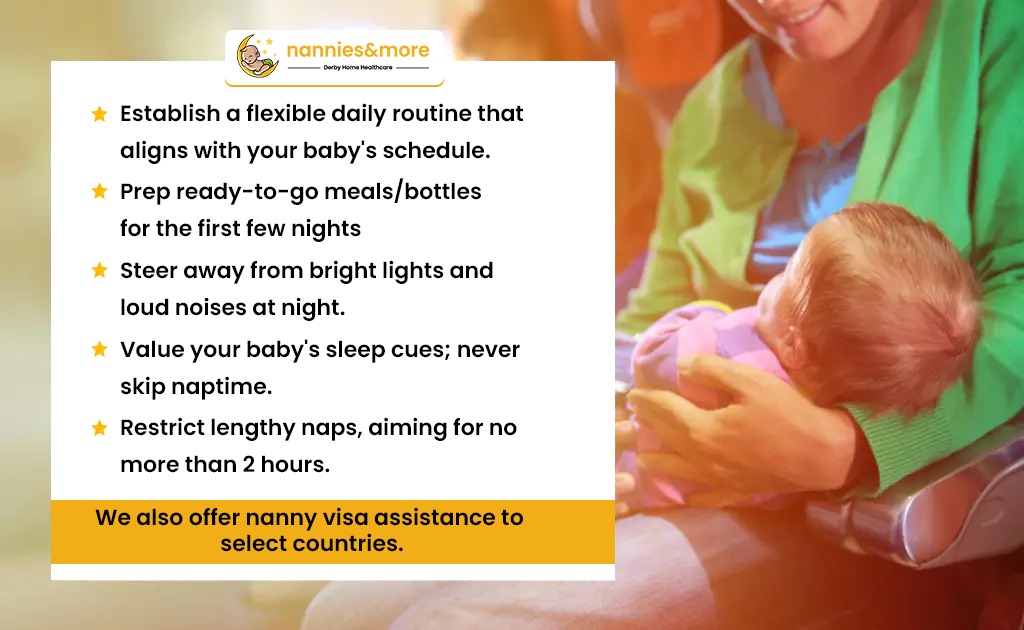Ever caught yourself saying, ‘We’d love to travel with our baby, but…’ Well, you’re not alone! Many parents dream of traveling with their little ones, but the journey from desire to reality often feels like walking through a maze of question marks and unknowns.
At Nannies & More, we firmly believe that parenthood shouldn’t signal the end of your passion for adventure and exploration. Our goal is to offer parents the necessary guidance and support through our expert tips, turning your ‘buts’ into ‘let’s do it!’. We want to prepare you and your family for common challenges and equip you with tips and tricks that pave the way for stress-free travelling with your little adventurer. A few tips below:
1. Flexibility is key
As with all aspects of parenting, travelling with your baby is going to be a learning process. Individuals, including babies and toddlers, vary in their ability to adapt to time changes. Your passion for travel as an adult doesn’t guarantee that your child will be an effortless traveler. Similarly, if they encounter difficulties as a baby, it doesn’t necessarily imply that they will always pose challenges when traveling. Whether it’s tweaking nap times or being open to new sleep arrangements, a flexible approach helps your baby adjust more easily to unfamiliar places, ensuring a more enjoyable and stress-free travel experience for both you and your precious little one.
2. Morning Sun for Smooth Time Zone Transitions
Start your baby’s day by letting them bask in the morning sun. Kickstart your day between 6 am and 8 am local time to help your baby smoothly adapt to the new time zone. By incorporating this simple adjustment into your travel routine, your little one gets the most out of sunlight exposure. This simple practice is incredibly helpful in helping them adjust to the local time of new places. Sunlight, a natural regulator of melatonin, commonly referred to as the natural sleep-inducing hormone, plays an important role in aligning the circadian rhythm. Embrace this straightforward and effective method to gently guide your child into a new sleep routine when navigating different time zones.
3. Strive for Familiarity
Maintaining familiarity would feel like a warm hug for your baby in an unknown place. Enhance their adjustment by packing their comfort companion—whether it’s their snuggly blanket or a favorite toy. So, grab their beloved item, and make their transition to a new place smooth experience.
4. Choose Playtime over Prams
While it may be tempting to place your child in the stroller or carrier, if they are walking, it is a good idea to let your little explorers engage in sufficient physical activity during the trip. Regular movement is vital for maintaining a healthy body, so encourage them to run around in a nearby playground or enjoy some playful jumping on the hotel room beds.
5. Limit Each Nap to 2 Hours
Cap each of your baby’s naps to a maximum of 2 hours. This practice ensures that your baby enjoys a more extended sleep during bedtime, preventing any further delay in adjusting to the new time zone. Additionally, wrap up your baby’s last nap with ample time for a complete wake window before your child’s bedtime in the new time zone.
6. Maintain a Consistent Bedtime Routine
Maintaining a bedtime routine, especially in a new environment, is a game-changer in preparing your baby for a good night’s sleep. Dim the lights and power down screens 15-30 minutes before bedtime to foster a calming environment conducive to restful sleep. Moreover, stick to your bedtime routine from home as far as possible, whether that includes a sound machine, wearing a sleep sack or reading a book together before bed.
7. Anticipate your Baby Waking-up During the Night
Anticipate occasional nighttime waking as your baby adjusts to time changes. It’s completely normal and doesn’t signify a regression in their sleep habits. If your baby wakes during the night, maintain a dimly lit room and soothe them back to sleep with gentle tapping or calming lullabies. If they are wide awake and ready to play, engage with them in a quiet activity in your bed with you until they get sleep, watch out for signs for getting sleep and hopefully they’ll be ready to be back asleep in no time.
Tiny Traveler Essentials: The Ultimate Baby Travel Checklist
Parents are commonly advised to initiate their travel plans with their young children when they are between 3 and 9 months old. This timeframe is preferred as children at this stage haven’t completely developed mobility, ensuring a more manageable travel experience. Additionally, it’s also recommended to travel after a child has completed 2 or 3 years old, aiming to bypass the challenges associated with the toddler phase.
Nevertheless, if you’re planning an upcoming travel with your young explorer, don’t miss out on the valuable insights coming your way. Navigating your child’s travel needs can be puzzling, but packing their travel bag shouldn’t be. We’ve prepared a list of must-haves to ensure that your journey with your little one is both smooth and enjoyable. Whether you’re an experienced traveler or a first-time parent on the move, these essentials will keep you covered
- Secure Essential Travel Documents:
Before you embark on your next travel adventure with your little one, make sure you’ve got your child’s passport and visa squared away. Don’t overlook the basics – tag your luggage with contact information and keep those important medical records and insurance details within arm’s reach.
- Pack a Well-Stocked Carry-On Bag:
Don’t forget to pack a generous quantity of diapers and wipes for convenient changes, along with comfy attire to ensure that your little one stays relaxed throughout the journey. Remember to bring a snug blanket to provide warmth, particularly during long flights or in colder destinations. Additionally, prioritize carrying bottles and formula to fulfill your baby’s feeding needs during the trip. Thoughtful preparation ensures a more comfortable and enjoyable travel experience for both you and your little traveler.
- Don't Forget the Baby Gear:
Equip yourself with the must-haves like a dependable pram, a reliable baby monitor, and a secure car seat to experience a safe and comfortable journey. If you are traveling long distances by air, consider asking the airline staff for an airplane bassinet to enhance the comfort and ease of your child’s journey, as well as your own.
- Dress Your Little One in Style:
Make sure that the items you are packing align with the destination’s weather conditions. Pack a variety of adorable onesies, comfy sleepwear, a sun hat with sunglasses, a cozy beanie, and of course, cute socks and shoes. Don’t skimp on the swimwear for any impromptu water adventures!
- Feeding Essentials on Hand:
Ensure you’re ready for feeding time with bottles, formula, bibs, and the essential bottle-cleaning duo – a bottle brush and detergent. If you require, pack a nursing cover to add a touch of privacy for you and your baby.
- Changing Station Must-Haves:
Be prepared for diaper changes with an ample supply of diapers, wipes, rash cream, a change mat, and a hand sanitizer for cleanliness on the go.
- Entertainment for Your Little Traveler:
Keep your baby entertained during the journey with a variety of their favorite toys, books, and a tablet loaded with their favorite shows – because a happy baby makes for a happy trip!
- Safety and Hygiene on Lock:
Prioritize safety and hygiene with a well-packed first-aid kit. Pack a mosquito repellent to ward off unwanted bugs, baby-friendly toiletries, and, of course, sunscreen to protect your little one’s delicate skin from harmful sun rays.
As we wrap up this guide on the Tiny Traveler Essentials, remember that the key to stress-free journeys with your little one lies in thoughtful preparation. So, make sure to secure your documents, pack comfy clothes, and ensure that their feeding, entertainment, and changing needs are met. These travel tips guarantee a smooth and enjoyable journey for both you and your tiny traveler. Happy travels!




